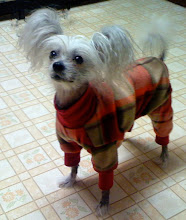
So now we finally had a name to put to some of this discomfort. Louie still had other problems—the skin problems, the diagnosis of Cushing’s disease—but we at least had an inkling about the gastrointestinal distress that was plaguing him and threatening his life. I was so relieved; it wasn’t cancer!
My euphoria at that bit of news was short lived, however, as I began to read all I could find about intestinal lymphangiectasia in dogs. What I learned was both troubling and inconsistent. Reports about prognosis ranged from “guarded” to “poor.” Other sites said that the disease can be managed, in some cases, but not cured. Still other sites offered more hope, saying that the disease can sometimes be secondary to other problems, and that in those cases resolving the primary problems will cure the disease. Many reports talked about owners euthanizing their pets within the first two years after the diagnosis. At least one page I landed on said that no animal had been reported to have lived beyond two years with the disease.
My online friends at the Chinese Crested site I frequent rallied around us again, as they had been doing all along, and there I learned of at least one dog, a friend’s Yorkie, who had the same disease and was still going strong eight years after being diagnosed. This gave me needed hope. We increased his daily cyclosporine to 50mg twice a day, a whopping 10 times the normal dose for a dog his size. I started Louie on the low fat prescription diet that was recommended. The vet said that I should notice improvements after about a week, and indeed, I did soon notice some very slow, incremental changes.
He was so weak to begin with that the improvement took a long time. Over the next few months we saw nothing too miraculous, just a slow and steady increase in energy, but to me, these were huge things. There was the first time he sat up in his bed with his head up for more than a moment and looked around as though he were finally engaged with his surroundings. The first time he got out of bed on his own. The first time he came by himself into the den and wanted me to pick him up. The first time he got up on the couch by himself again. The first time he jumped into my lap again. The first time he wanted to stay in my lap instead of going back to his little bed. The first time he wanted to walk around a little bit in the back yard again.
He was still skin and bones, was clearly still “out of it” in a way, but it also was clear that he was improving. We continued to have incidents of vomiting and diarrhea, I still frequently had to clean up poop and give him a bath when I’d come home from work, but things were getting better.
Louie usually slept with us in the bed. I’d hold him next to me so that I could feel his movement in case he needed to get up and go outside to poop or pee in the night, which happened frequently. Sometimes he’d vomit, and sometimes I’d have him sleep on pads in case he made a mess, to make it easier to clean up. One night he got quite sick, and after cleaning him and everything else up, I decided to put him into his crate, because I was very tired and really needed to sleep.
After a couple of hours, I got up to check on him. The scene in his crate was horrifying. He sat, calmly, in the middle of his bed, and there was blood everywhere. Blood on the walls, blood on the floor, blood all around the edges of his bed. I woke up my husband and told him that Louie had been vomiting blood. We called UC Davis emergency and they told us that, if it happened again, we should bring him right away, and otherwise to bring him in the morning.




No comments:
Post a Comment